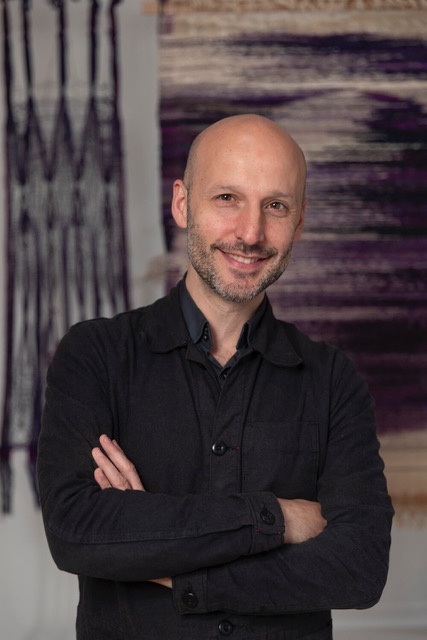Kodai Ujiie’s signature work began ten years ago – with a dull thud. It was 2013, and he was completing his degree at Tohoku University (studying there alongside the outstanding ceramic artist Hiroshi Goseki, who is also represented by Ippodo Gallery). One of the key works for Ujiie’s graduating show was a large vase made in the manner of a Korean Moon Jar, with the upper and lower sections thrown separately and joined together. He pulled this ambitious work out of the kiln, and tapped it, hoping to hear the bell-like ring that signals a properly fired pot. Instead, he heard the disheartening muted sound that every potter fears. The piece was cracked – perhaps ruined.
But Ujiie did not give up so easily. In a flash of inspiration, it occurred to him that he could make this accident a happy one, by filling the cracks in the object with lacquer – a variation on the long-established tradition of kintsugi. Typically this is done with colorless lacquer, which is then covered in gold leaf. Ujiie, wanting to signal a more contemporary sensibility, instead used a lacquer pigmented bold red. An avant gardiste was born.
Ever since, polychrome lacquer inlay has been the distinctive leitmotif of his work. The technique gives his pieces a bold, painterly appearance, making them something quite new in Japanese ceramics, while also in keeping with some of the most fundamental principles of the tradition. It might be said that a great teabowl is an event, as much as an object. Its fixes the moment of its making and firing forever in time.
Ujiie’s lacquer, and his increasingly expressionist vessel forms, exemplify this immediacy. His works are often asymmetrical, with thickly formed lips and craggy, fissured surfaces, and bright glazes coursing down them like Technicolor waterfalls. They at once convey the seismic, even traumatic quality of natural catastrophes – the earthquakes and tsunamis that periodically inflict their terrible might on Japan – and radiate a delight in the happenstance, the instinctive energy that only an embrace of accident can bring to art.
Again, there was a specific moment (also in 2013) when Ujiie realized this possibility: a face-to-face encounter with the famous Ido teabowl, “Kizaemon,” which he saw at the Nezu Museum in Tokyo. Made in Korea in the 16th century, originally as a humble bowl for eating rice, this is one of the most venerated ceramic artifacts in Japan, named a National Treasure in 1951, and famously praised by the leading theorist of mingei, Soetsu Yanagi, as “something that anyone could have bought anywhere and everywhere,” yet unsurpassed in merit.
It would seem unlikely that such a well-known, canonical work could spur new insight in the 21st century, but this is exactly what happened for Ujiie. He says that he long had an inferiority complex about his own physical appearance (and which of us could say differently, in these days of mass media and digital avatars?). Seeing the extraordinary power of the Kichizaemon in person helped him to feel differently. Like Yanagi, he saw value in the Kizaemon teabowl’s humility. But Ujiie also saw it anew, as an emblem of identity, of self-acceptance.
This too is an idea with deep resonance in ceramics. With some important exceptions (like the raku tradition, in which singular teabowls are created in the spirit of masterworks), this is an art form that is usually practiced en masse, by the kiln load. What distinguishes a great potter is not just the ability to make something beautiful, but to actually see it once it has been made: to pick it out from among its brethren, and see its specialness. It is a metaphor for the way we should treat one another, as humans: at once equal to one another, and also invested with our own unique spirit.
This is what the works of Kodai Ujiie say to us. Aesthetically, they are vital contributions to the Japanese ceramic tradition. Ethically, they show us how to navigate a world that is never perfect, but nonetheless filled with beauty – the only world we have.

Glenn Adamson
Independent Curator and Art Writer

